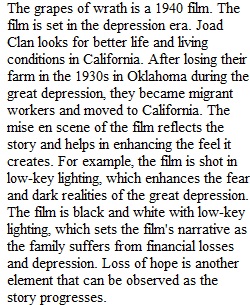


Q There is “an assumption that American cinema reveals both directly and indirectly, something about American experience, identity and culture.” (John Belton, American Cinema, American Culture, p. xvii) If we take the above statement as accurate, what can we learn about American culture during the period of the studio system by examining the films made under that system? This is a broad question, but I'd like you to narrow it down by analyzing a film of your choice from the Studio Era. A good approach would be to simply choose a film from the grey boxes at the end of the chapters. You may explore a film that piqued your interest while reading the chapter(s), or one by a star you like. In any case, limit your selection to films released between the late 1930s and the late 1950s. If you really want to, you may analyze more than one film, e.g. two films with Marilyn Monroe, or two comedies from the era, or a few John Huston films. The analysis will look more at specific aspects of a given film than your discussion board entries and dive a bit deeper into the history surrounding the film. A strong analysis will take into account stylistic elements, such as those found in Chapter 3, but it will also explain how the film relates to the societal conditions in which it was made, including the studio that made it and the historical situation at the time of its release. Plot summary is unnecessary; analyses that rely heavily on summary will receive poor grades. You will want to establish how the film reflects (or opposes) the societal values of the era in which it was created. You should rely on the textbook for ideas and support, but your argument should go further than simply stating what can be found in the book. Outside research is not strictly required, but you may choose to do so if you find it will bolster your argument or clarify the historical context of the film. If you do conduct any research, please use MLA or APA style. Length: 500-750 words.
View Related Questions